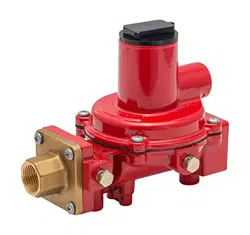Loading ...
Loading ...
Loading ...

R122H, R222H, R222, R232A and R232E Series
LP-Gas Regulators
4
approximately 10 psig / 0.69 bar or 5 psig / 0.35 bar inlet
pressure to a second stage regulator. On nal stage service
the regulator reduces container pressure for a high pressure
burner. The regulator is painted RED.
Installation
!
WARNING
All vents should be kept open to permit free
ow of air in and out of the regulator. Protect
vent openings against the entrance of rain,
snow, ice formation, paint, mud, insects,
water from an irrigation system or any other
foreign material that could plug the vent or
vent line or accumulate in the vent line.
LP-Gas may discharge to the atmosphere
through the vent. An obstructed vent
which limits air or gas ow can cause
abnormally high pressure that could result
in personal injury or property damage.
The Types R232A, R232E, R122H and R222H
are not suitable for indoor installations.
Failure to use a vent line with Type R222
second stage regulators in indoor
applications can cause a hazardous
accumulation of gas which could result in
personal injury or property damage.
Never use the Types R122H, R222H and
R232E (pounds-to-pounds) regulators on
low pressure (inches of water column)
service because personal injury or property
damage could occur.
Figure 3. Tank Installation
General Installation Instructions
Before installing the regulator,
• Check for damage, which might have occurred
in shipment.
• Check for and remove any dirt or foreign material,
which may have accumulated in the regulator body.
• Replace old pigtails. Blow out any debris, dirt or
copper sulfate in the copper tubing and the pipeline.
• Apply pipe compound to the male threads of the pipe
before installing the regulator.
• Make sure gas ow through the regulator is in the
same direction as the arrow on the body. “Inlet” and
“Outlet” connections are clearly marked.
Installation Location
• The installed regulator should be adequately
protected from vehicular trafc and damage from
other external sources.
• Install the regulator with the vent pointed vertically
down, see Figure 2. If the vent cannot be installed
in a vertically down position, the regulator must be
installed under a separate protective cover. Installing
the regulator with the vent down allows condensation
to drain, minimizes the entry of water or other debris
from entering the vent and minimizes vent blockage
from freezing precipitation.
• Do not install the regulator in a location where there
can be excessive water accumulation or ice formation,
such as directly beneath a down spout, gutter or roof
line of building. Even a protective hood may not provide
adequate protection in these instances.
T14447-A2
Loading ...
Loading ...
Loading ...
